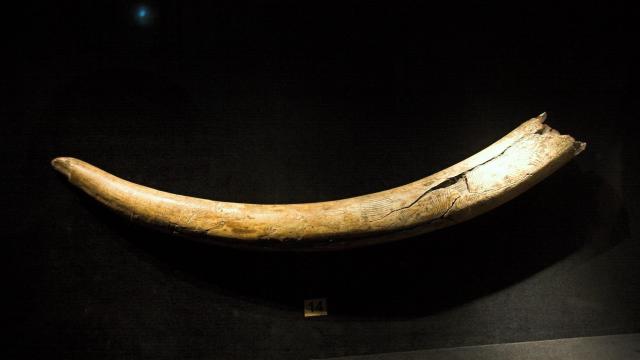A female mammoth that lived 14,000 years ago made a trek across hundreds of miles of tundra to a hunter-gatherer settlement in central Alaska, according to a team of scientists that recently scrutinized isotopes in the tusk.
The massive proboscidean was 20 when she died, according to the team’s research, published today in Science Advances. Though it’s not clear whether the animal was killed by the humans, the settlement’s location may have been chosen to capitalize on the mammoth herds that went there.
In Alaska, woolly mammoths (Mammathus primigenius) overlapped with human populations for at least a millennium. Humans definitely made use of the overlap; there is archaeological evidence that humans used mammoth ivory and bones, but there’s less direct evidence of mammoth hunting. To better understand how the two species may have overlapped geographically—and thereby interacted— the research team analyzed DNA and isotopes locked away in a mammoth tusk named Élmayųujey’eh. Audrey Rowe, a PhD student at the University of Alaska Fairbanks, led the study.
Much can be gleaned of a proboscidean’s life from its tusks, which like tree rings, reveal details of the animals’ growth rate and lifespan. Isotopes in the tusks reveal aspects of the animals’ diets, and by proxy, their geographic movements over time. In 2022, a team, which included some of the members of the recent team, looked at isotopes in a 13,000-year-old mastodon tusk to reveal the animal’s life, which was spent in the Great Lakes region and ended when the animal was 34, stabbed in the face by another mastodon.
Élmayųujey’eh was found alongside contemporaneous mammoth remains belonging to other individuals. The remains were found at the Swan Point archaeological site in Alaska’s interior. Researchers think the site was a seasonal workshop for Ice Age humans in the area.
DNA from the Swan Point tusk indicated the mammoth was closely related to the other mammoths found on the site. She didn’t move much early in life, according to the Strontium isotope analysis, and was probably living in southeastern Beringia. But when she was around 10, the mammoth traveled 621 miles (roughly 1,000 kilometers) over a 2.5-year span. She spent the last three years of her life in interior Alaska, and died late summer or early autumn—coincident with the seasonal occupation of the Swan Point site.
Despite this, the researchers say there is no explicit evidence that the animal was killed by the humans. Any potential cut marks that may have been on the mammoth remains at the site were “erased” by natural process after the bones were left there, the team stated.
Nevertheless, the collection of mammoth bones at the site is a reminder that the two species shared the region, if only for a time. The tusk itself is a testament to the amazing stories of lifeforms that died long before us—and indeed, the amazing science that makes those stories attainable.
